So Many Choices
Cabinet shops have an increasing number of options to fabricate, assemble and install jobs.
The ways in which custom cabinet shops can design, build and deliver jobs has changed dramatically over the past decade. And the pace of change is still increasing. Among a woodshop’s evolving options are a much more comprehensive array of outsourced components, the perfection of ready-to-assemble joinery, the growth of snap-together hardware, plus giant leaps in robotics and material handling.
Here’s a chilling thought – a ‘cabinetmaker’ could now theoretically operate an entire custom woodworking business without owning a single tool… except a cellphone! All he or she would need is a crew of subcontracted installers and a website. Given the realism of virtual rendering, sales scan be made based on images of rooms that don’t yet exist. And a salesperson could place an order online and have an entire job delivered on a pallet directly to suburbia. There’s nothing really new here – most of those technologies have been around for a while.
So, why isn’t that scenario happening on a massive scale?
While these developments might seem at first glance to threaten traditional custom cabinet builders and to change the very nature of the industry, there is actually a positive upside. New technologies present more opportunity than threat. As with any other service business, custom building is much more than the sum of its parts. Some homeowners and even institutions are short-circuiting the system and ordering online, but discerning buyers still understand the value of experience and quality. Arming those values with new tools and technology only enhances options for custom cabinetmakers.
The key here is the word ‘custom’.
Since the birth of serious online retailing about a decade ago, we have seen a radical change in consumerism worldwide. Virtual shopping has made huge inroads into brick and mortar retail, and shopping malls across America are evidence of the impact that has had. The companies that have survived, and even thrived, have found a way to marry physical and website shopping, and deliver a hybrid solution that satisfies both customers’ online savvy and the need for tactile rewards. And in this lies the future of cabinetmaking.
Home store retailers, for example, have found that their customers shop online but come to the store to buy things that are “too heavy to have delivered.” On the box store’s website, they will check prices and availability, and then usually leave for a while to search competitors’ sites. But as long as the prices aren’t too out of line and the product is comparable, they tend to physically visit the home store that is closest to their own location and purchase physically larger items there.
That experience mirrors the way in which cabinet buyers shop. And while many will go to the big box store to buy casework, those buyers don’t quite reflect the homeowners and contractors who have traditionally reached out to custom shops. It’s a different market, and a different audience. The perception of quality is a strong motivator, especially for people with good taste who are investing a large amount of money in a product that needs to be both durable and aesthetically pleasing over a long period of time.
People who want the best still seek it out. It’s up to cabinet shops to use this new generation of tools and technology to make their choices not only more convenient, but also more appealing.
Outsourcing
Not too long ago, outsourcing just meant buying in the drawer boxes, and soon after that the doors. Now, a shop can essentially subcontract an entire kitchen, even the custom, one-of-a-kind elements. Suppliers can provide moldings, curved panels and doors, corbels and furniture feet, color matching, a dizzying array of material choices, and even incremental sizing that eliminates filler strips and fills spaces properly with casework. They can deliver wire or glass doors, paint or clear finishes, and anything that can be drawn in CAD.
Given that, cabinet shops can use outsourcing to fill some or even all of a customer’s needs without having to manufacture components in-house. So, how is that different from the guy with the cellphone, or an online showroom?
Well, think about what a custom shop has to offer. An estimator doesn’t just measure a room. He/she also creates a new relationship with a client and begins to personalize what can be a very large and usually quite intimidating purchasing experience. The estimator also consciously, and often subconsciously, evaluates the customer’s style and taste, walking through the home and even the neighborhood. Everything from family photos to flooring choices are part of the package, each nuancing the choices that the shop will offer in its design. Instead of one size fits all, the custom shop offers a tailored catalog that reaches out to a single buyer.
Plus, the custom shop has samples. These may be physical doors and drawer fronts, examples of dovetailed joinery, a ring of moldings or perhaps some countertop samples. Yes, the guy with the phone can show a customer a rendered drawing, but the custom shop can do that and also walk the client through a couple of completed kitchens, and usually a physical showroom. And the customer who orders directly online has to become their own contractor, which means finding subs to hook up utilities, install the cabinets, make the countertops and deal with a hundred other headaches. An established woodshop already works with a team of professionals and can guarantee the quality of their work.
The primary upside to outsourcing for a shop is cost. It helps keep bids competitive, but it also allows a shop to offer a broader range of cabinet and accessory choices. By using more than out outsourcing supplier, a shop can offer more options in more stiles and material choices, and that means more sales. And because the machines aren’t as busy, the shop can take on more jobs with fewer staff and create more volume-based profit.
Outsourcing has definitely opened up a new area of competition for custom shops, but it has on balance opened up a lot more opportunities for growth and margins.
Ready-to-assemble
RTA doesn’t just apply to outsourced cabinets. Yes, it has made it possible to have a job delivered to the jobsite and assembled there. But a woodshop can also use the technology in-house as a way to flat-pack and transport an entire job. Large casework can pass through narrow doors and navigate stairway turns because it’s well, flat. Floor space in the shop is no longer filled with completed casework waiting to be delivered at the whim of a plumber or electrician. Standard parts can be made on slow days and inventoried on shelves, ready to assemble into space-hogging casework only as needed. Jobs can be delivered to a home and stored in the garage or a spare room until the contractor has torn out the old kitchen, and the new cabinets don’t make life miserable for the homeowner during the wait.
Most RTA hardware is intuitive and repetitive, so the training curve is short. Many solutions still use glue but eliminate clamping, so the process is much quicker. Others even do away with the glue, and only need a few basic tools for installation. Many RTA cabinets can be disassembled and replaced if damaged. In Europe, renters and even homebuyers began a tradition of taking their snap-together laminate floors with them when they moved. Now, some are even taking their kitchen cabinets along, as many countries have a tradition of selling homes without fitted kitchens.
Manufacturing snap-together RTA cabinets in-house is still a challenge without using hardware. Some industrial suppliers have found a way around that by using all-wood components and joinery. For example, Ikea has come up with the Wedge Dowel, which is an all-wood solution that allows customers to disassemble and reassemble furniture as often as they like without tools, glue or fasteners. Cabinotch (cabinotch.us) has a snap-together system that lets an installer build a box quickly and efficiently based on joinery rather than hardware.
More wood-only solutions will present themselves as robotics and CNC tooling evolve, but for now the most efficient way to build RTA casework in-house and assemble it on the jobsite is still to use hardware. And the options there have truly blossomed of late.
Snap-together hardware
The marriage of new hardware with the ability of CNC software (and for some shops, developments in aggregate heads) has given woodworkers a way to create pockets in just about any plane. This has revolutionized the way that we assemble boxes, drawers and even five-part doors.
Among the newer technologies are machines specifically built for the Lockdowel fastener (lockdowel.com), such as the Scorpion LDR from CNC Factory (cncfactory.com) and the SmartShop LD4 from Laguna Tools (lagunatools.com). The Scorpion has four working zones, automatic material loading, laser guided robotic measuring, advanced wireless barcode reading, and a single employee can run it. The Laguna machine features a one-piece welded tubular steel frame with 3-axis control for positioning. It also uses laser sensors to ascertain when a part is in position, and it has automatic centralized lubrication so it’s mostly maintenance free, outside of replacing bits. A Windows front-end control makes it easy for first-time users to learn how to operate the machine.
Fastenlink (fastenlink.com) is another hardware option, and it uses standard equipment as it is essentially just a specially shaped plastic dowel. One end goes in a hole, and the other slips into a ramped slot. Slide the parts, and they lock together. It’s fast, easy to get into, economical, and above all simple. Installers can assemble RTA casework on the jobsite with little more than a rubber mallet.
Lamello has introduced a new cabinet assembly connector called Cabineo through its U.S. distributor, Colonial Saw (csaw.com). The device is inserted into a surface-only routed shape on the cabinet (no edge drilling), and insertion can be done during production or on the jobsite. If it’s done at the woodshop, components can be flat-packed for transport and installers don’t need to deal with loose fittings. The system can be used with all kinds of CNC machines, including very simple 3-axis and nested-based ones. Installers can assemble the finished product with just a cordless drill, and then clip colored cover caps in place.
Häfele America Co. (hafele.com) is headquartered in Archdale, N.C., and is the U.S. branch of a German multi-national that was founded in 1923. Among its newer innovations is a clever little connector called the SC 8/25. After a woodworker drills a couple of 8mm holes, there’s no need for tools, glue or clamps to assemble smaller pieces of furniture. They just push together, and as they slide into the holes they ratchet, expand, and lock in place.
OVVO’s new V-1230 invisible connector has a deeper profile than the company’s award-winning V-0930, and it significantly increases the holding strength delivered in chipboard materials. It works best in thicker, high-grade chipboard and sheet stock such as high-pressure laminates, composite material and solid woods. Biesse recently named OVVO as one of its Selected Partners. OVVO fasteners (ovvotech.com) are available in the U.S. through the E. B. Bradley company in Los Angeles.
The Titus Group has a number of cabinet connector options on its new website (cabinet.titusplus.com). Among the latest is the Cam 5000 receiver, which screws into a round pocket in one component and then accepts any one of three screwdriver driven metal dowels.
Cabinet shops and furniture builders might also want to keep an eye on Knapp (knappconnectors.com), an Austrian company that makes furniture and millwork connectors. It showcased its catalog at IWF 2018 in Atlanta. The company has developed more than 50 patented connecting systems over the past 30 years and has begun to focus on the U.S. sector over the past couple of years.
One other unusual option for cabinet shops might be an application of the pneumatically driven wooden finish nails made by LignoLoc. This is a division of the Beck Fastener Group (beck-lignoloc.com), which has offices in Austria, Germany, Italy and the U.S. While the technology is still young, and primarily aimed at sheet and timber components, there is definitely some potential for this wooden, friction-fit, glue-less fastener that is collated in coils and driven by a nail gun. It can be CNC machined or passed over saw blades without causing damage to bits, cutters or inserts, so it should be of interest to furniture and cabinet makers who work with large components.
Robotics and material handling
Woodshops that have already invested in CNC equipment are seeing an evolution in material handling and robotics, and this is creating a number of new production process choices. Programmed robots can improve the manufacturing regimen by reducing errors, working 24/7 without lunchbreaks, analyzing and even initiating their own maintenance, and speeding up feeding and off-loading. Robots are being used to stack parts, move them between workstations, do glue-ups, mill for and insert hardware, sand, and apply paint or finish in multiple planes (thanks in large part to innovations in the auto industry).
A single robot can load and unload several CNCs, eliminating even minor delays and increasing productivity. One experience in the auto industry, however, does raise a small flag. If an assembly line depends on several robots, and one goes down, the shop can’t quickly replace it with an employee. The entire line will have to shut down until repairs are made or a replacement is installed. So, woodshops considering this option may want to spend some time considering redundancy – that is, having a replacement on hand, or at least inventorying parts and training qualified people to do both emergency and routine maintenance.
Robots can also assemble cabinets and furniture, and a new wave of artificial intelligence (AI) is beginning to allow them to ‘think’ through complex processes. That is, they can now go beyond performing single steps in a series. For example, a university in Singapore recently had one unpack and then assemble an entire Ikea chair by using parts recognition and orientation software. New CNC capabilities (up to seven axes) are giving cabinet shops more choices in using robotics during milling, sawing and drilling operations, especially on complex and curved work. The robot can move either the spindle or the part, which essentially means that it can finally work in true 3-D.
Down the road
Beyond new ways to outsource components, ship RTA, assemble with hardware and update the CNC process, cabinet shops are also witnessing a concurrent renaissance in materials and finishes. Driven by both consumer tastes and environmental issues, these new panel and even countertop options are creating choices that allow a shop to use existing machinery and methods to deliver a whole new category of products.
The future looks to be filled with cost-cutting, labor-saving production methods and unlimited decorative choices. For cabinetmakers who espouse the technology and trends, things look very promising.
The guy on the cellphone has the wrong number.
This article originally appeared in the April 2019 issue.







